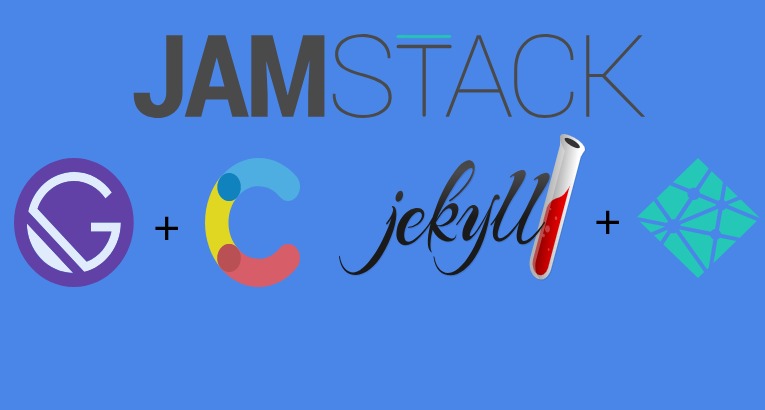
JAMStack for Digital Marketing - The Beginners Guide
Websites are integral part of a Digital Marketer's daily routine whether it's about writing a blog, generating leads, or launching marketing experiments. Wordpress has always been the front face of marketing community since about 60% of marketers prefer to use it for their projects. And it's not going to change anytime soon...
But there's a catch: As marketers, you don't need to rely on wordpress everytime you are about to launch a marketing experiment. JAMtack enables marketers to build truly competitive, superfast, lightweight, and SEO-friendly websites.
In this article, I would like to mention my thoughts on JAMStack and why I think it could be the next big thing for the Marketing community.
The scalable options available for marketers to launch marketing experiments
There are many options available for marketers for launching their marketing experiments, but only a few are scalable and cost-efficient. Although unscalable options have their place in building user acquisitions but if you want to run successful marketing experiments, you need scalability.
To answer it right up front, the scalable options to launch marketing experiments are:
- WordPress
- Webflow
- Blogger
- Weebly
- Wix
- JAMStack
Almost all the marketers and SEOs are familiar with either all or a few of the aforementioned channels. The very obvious reason why marketers choose one of these options to launch the marketing experiments and campaigns boils down to these things: money, developers, and marketing team.
Since this article is not to talk about all these platforms, but only one among them: JAMStack. Let’s dig into the meat of the matter already!
What is JAMStack and What we, as Marketers, should Know?
The word JAM in JAMStack refers to JavaScript, APIs, and Markup. For starters, here’s what these specific letters mean:
- J for JavaScript: the client-side language to build your website
- A for APIs: the APIs are the interface to access all database actions and server-side actions. But it does not mean that it involves the server.
- M for Markup: the Markup here means a piece of code to the pre-render website on the browser. The code can consist of a tag or some elements that tell browsers how to display the web page.
In simpler terms, JAMStack is a tech-stack that is referred to as a way to build static websites -- a set of HTML files that represent an actual webpage. In general, static websites don’t involve rendering from a server, but a browser. Having said that, most of the back-end processing takes place in the user’s browser.
Moreover, since there is no involvement of server and backend, the scalability comes more naturally and conveniently. What’s more, JAMStack websites are by default secure as there is no scope of database and server security attacks.
Mathieu Dionne, the lead Marketer at Snipcart, defines it succinctly,
“JAMstack is a significant shift in focus from the now abstractable backend to the now powerful frontend.” - Mathieu Dionne
For marketers who are still new to this concept, here’s what JAMStack websites may have for you in-store:
- Speed: Since the content gets served via a CDN, no unnecessary dealing with server requests. Hence more speed!
- Security: Since serverside and database operations are already out of the equation, there are no chances of security exploits.
- Scalability: With storage like Github pages, there is no need to worry about storage and hosting. Even 100,000 visitors are no concern for you as a marketer. Scale as you want and experiment with campaigns without worrying at all!
- Stability: 100% uptime and availability with Github pages.
The JAMStack Ecosystem - The Sky is the only Limit ...
If you are still finding it confused to understand the whole JAMStack idea, understanding the community around it might help.
There are hundreds of tools and technologies for building the JAMStack websites and the number only keeps on increasing.
For starters, here are definitely some technologies that stand out from others:
The Frontend JS frameworks
JS is everywhere, even in JAMStack. You might have probably heard the terms Single Page Applications (SPA) and Progressive Web Apps (PWA). There is a bunch of frameworks or libraries that help you to build those: Angular, React, and Vuejs. In the JAMstack, you will use these technologies to deliver safe, fast, and dynamic sites without relying on web servers.
Since you will be using these technologies in the frontend, here are some in-hand best-practices that you’d want to utilize:
- Deliver the content via a CDN or via an API, such as Content Management System
- Leverage the credibility and benefits of serverless functions and webhooks to make your site dynamic, and
- Establish a git workflow for automatic deployment and continuous workflow.
For marketers, here are some of the benefits over the top of my mind:
- Better user-experience: Serving static content from globally-distributed CDNs with re-direct logic will allow you to reliably serve information to your users fast.
- Cost: Since you are uncoupling your frontend from backend, you can directly tell your developer to focus only on the frontend side. Not only this will save you some bucks, but also speed up the development process. Also, storage with cloud and Netlify free hosting is also affordable options available.
- CMS: Yes, you read that right. With JAMStack, you have the liberty to add a convenient and user-friendly CMS to save you the headache for playing around with text-editors every time.
- Scalability: I mentioned it already, haven’t I?
- Improved technical knowledge: In a world where technology is in everything we use, you should not shy away from learning it. JAMStack can greatly improve your technical skills including HTML, CSS, Javascript, and API integration.
However, not every tech stack is all sunshine and rainbows. Here are some downsides of using JAM Tech stack for marketers:
- Time: Adding content from a CMS like Netlify and Headless is not exactly the same as with WordPress. At worst, it can take you a lot of time to learn it.
- Bugs: As new tech keep adding in JAMStack, you might come across some cases wherein an existing bug has not solved for a period of time.
- Lack of some features: Since JAMStack community still has a long way to improve and get mature, there can be some features that you can’t expect in the form of a plugin or a tool. In worst-case scenarios, you will need to code it from scratch.
Static site generators
With JAMStack, you will be probably dealing with a lot of code. But it doesn’t mean that you are required to wear your developer hat every time and code all features manually. Luckily, some static site generators like Jekyll, Hugo, Pelican, Gatsby, etc. gives you the flexibility to implement basic functionalities like SEO without deeging deeper into code.
Although I wouldn’t deny the fact that it will need some developer skills upfront (and so does every framework, yes even our favorite WordPress!).
WordPress vs Static site generators
Okay. Let’s make it clear upfront: WordPress is a good choice for all of our marketing experiments since it is easy to set up and run. But it isn’t the only choice available. And I see no reason why it should?
Of course, it gives you the liberty to use plugins for even complex features like WooCommerce. But, think about it for a minute: is it convenient every time to increase your hosting limit every time your marketing experiment goes viral?
I have seen WordPress websites going down even if they hit 1000+ visitors at a time. Is this what you call scalability?
Now you would argue that hosting from a good service provider or even cloud will rarely hit the rock bottom in marketing experiments. Yes, I’ll give you that!
But what’s with this search for a good hosting provider that you as a marketer should bother about? Think about this!
Besides, an average WordPress website needs about 20-30 plugins. Some of these may even slow down your website loading speed: read here and here.
Sure, it makes sense to use these plugins since not everything needs manual implementation. Makes sense! But if using plugins hinders your marketing experiments and growth, who’s to be blamed?
JAMStack websites are easy to build and host your content. Most importantly, they give you the benefit of speed and scalability. The options to host your web pages are numerous with GitHub Pages, Netlify, or Zeit being popular ones.
Content Management Systems for extending backend functionalities
With JAMStack, you can always integrate CMS to enjoy basic facilities like adding editor roles, managing user permissions, and adding content. There are tools like Netlify CMS, Headless CMS, and Contentful for that.
Since your end goal is building websites that are good for marketing experiments, it's recommended to use any CMS that has a robust API to send content to your site. In this way, you can store all of your content in a CMS even if you are not a fan of using GitHub Pages. In general, CMS like Netlify and headless can be easily integrated with whatever frontend stack you are using, and for static websites, you might also want to use static-site ready CMS options like Siteleaf and Forestry. Your options are endless, so you might as well want to google them and read about them.
The JAMStack use case for Marketers
For marketers, here are some options that can be part of your JAM Tech stack:
- Marketing website: If you are to build a website for your marketing efforts, use either Jekyll, Pelican, Hugo, or Gatsby to generate the website, deploy it on Github Pages, Netlify, and use Staticman, Netlify for form submissions. If you are not a fan of using markdown or HTML to format the content, use a CMS like Netlify CMS.
- eCommerce website: If you are to build an eCommerce website, use Reactjs for frontend and headless CMS as the content management system. You can also use existing solutions like Snipcart for eCommerce.
- Landing page: If you are to build a simple landing page to generate leads for an online business, Jekyll, Hugo, and Pelican have plenty of single-page themes available. Why not build a microsite for lead generation?
- SPA: If you are to build a SPA with dynamically generated content and good SEO, choose Next/ Nuxt.js to build statically generated applications. You can even convert these SPAs into PWAs just by adding manifest file and following the google lighthouse instructions.
Key takeaway: Try JAMStack, the next time you want to run a marketing experiment
Gone are the days when web used to be boring and slow. Today’s users expect the browsing experience as seamless and smooth. Forget slow load times, now your users truly value the secrecy and privacy of their confidential information.
Things Change! As we move closer to an era of all-things-digital, the way we approach marketing and user’s expectations also changes.
If you are not offering a good and engaging experience to your user, you are probably missing out on something very important. As marketing becomes more complex, the metrics like speed, performance, and scalability are more critical than ever.
Sure, JAMStack can be an infancy term for marketers but I see a huge potential in it to go mainstream and become a part of our tech stack. I would recommend you to try the JAMStack for atleast one of your marketing experiment and analyze the results.
Till then, Sayonara! Thanks for reading.
I enjoy writing about things I learn & I know, building scalable Digital Marketing campaigns, and learning a bit of web development, side-by-side.
When not in front of a screen I like to listen music, play guitar, read books, and binge-watch anime/ series.










